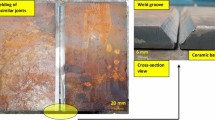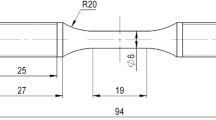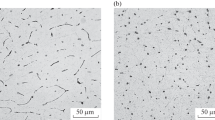Abstract
Assab 718 die steel was used to complete the anatomical tests of the modules produced by two different forging processes consisting of the traditional forging process and the liquid core forging process. The homogeneity and the service performance were compared in the composition, microstructure, mechanical properties, resistance to corrosion and surface roughness. The liquid core forging process improved the uniformity of the distributions of C, Cr and Mo elements. The macrostructures had no obvious defects and the grains at the half position were finer and more evenly distributed. The nonmetallic inclusions grade in the large module met the delivery requirements, while the module under the traditional one had ultra-wide sulfides. The section hardness and the tensile properties were more uniform. The Assab 718 was more corrosion-resistant through the electrochemical tests under the liquid core one. The laser confocal microscope tests showed it had a better polishing performance.















Similar content being viewed by others
Availability of Data and Materials
The data used to support the findings of this study are included within the article.
Change history
20 September 2023
A Correction to this paper has been published: https://doi.org/10.1007/s13632-023-00996-6
References
H.H. Liu, P.X. Fu, H.W. Liu, C. Sun, M.Y. Sun, D.Z. Li, A novel large cross-section quenching and tempering mold steel matching excellent strength–hardness–toughness properties. Mater. Sci. Eng. A-Struct. Mater. Prop. Microstruct. Process. 737, 274–285 (2018). https://doi.org/10.1016/j.msea.2018.09.046
H.H. Liu, P.X. Fu, H.W. Liu, D.Z. Li, Improvement of strength-toughness-hardness balance in large cross-section 718H pre-hardened mold steel. Materials. 11(4), 583 (2018). https://doi.org/10.3390/ma11040583
Z.Y. Li, J. Zhang, B.Q. Dai, Y. Liu, Microstructure and corrosion resistance property of laser transformation hardening prehardened AISI P20 plastic die steel. Opt. Laser Technol. 122, 105852 (2020). https://doi.org/10.1016/j.optlastec.2019.105852
C. Yao, M. Wang, M.F. Cheng, L.D. Xing, Y. Wang, Y.B. Gao, Y.P. Bao, Effect of dynamic soft reduction range and amount on central segregation in bloom and the resulting microstructure in the rod of GCr15-bearing steel. Steel Res. Int. (2022). https://doi.org/10.1002/srin.202200495
M. Irani, A.K. Taheri, Effect of forging temperature on homogeneity of microstructure and hardness of precision forged steel spur gear. Mater. Chem. Phys. 112(3), 1099–1105 (2008). https://doi.org/10.1016/j.matchemphys.2008.07.044
H. Hoseiny, F.G. Caballero, R. M’Saoubi, B. Högman, J. Weidow, H. Andrén, The influence of heat treatment on the microstructure and machinability of a prehardened mold steel. Metall. Mater. Trans. A. 46(5), 2157–2171 (2015). https://doi.org/10.1007/s11661-015-2789-4
H. Hoseiny, U. Klement, P. Sotskovszki, J. Andersson, Comparison of the microstructures in continuous-cooled and quench-tempered prehardened mould steels. Mater. Eng. 32(1), 21–28 (2011). https://doi.org/10.1016/j.matdes.2010.06.045
Y. Luo, X.C. Wu, H.B. Wang, Y.A. Min, A comparative study on non-quenched and quenched prehardened steel for large section plastic module. J. Mater. Process. Technol. 209(14), 5437–5442 (2009). https://doi.org/10.1016/j.jmatprotec.2009.04.019
Y.A. Min, Q. Zhou, Y. Luo, D. Li, X.C. Wu, Tempering process to improve hardness uniformity of plastic module steel. J. Iron Steel Res. Int. 19(12), 53–58 (2012). https://doi.org/10.1016/S1006-706X(13)60032-1
M. Esmailzadeh, R. Mousavi, M.M. Esfahani, L. Pezzato, E. Karimi, Effect of cold forging on mechanical and corrosion behaviors of carbon steel plate. Int. J. Press. Vessels Pip. 198, 104659 (2022). https://doi.org/10.1016/j.ijpvp.2022.104659
M.Y. Tu, C.A. Hsu, W.H. Wang, Y.F. Hsu, Comparison of microstructure and mechanical behavior of lower bainite and tempered martensite in JIS SK5 steel. Mater. Chem. Phys. 107(2), 418–425 (2008). https://doi.org/10.1016/j.matchemphys.2007.08.017
D.V. Edmonds, K. He, F.C. Rizzo, B.C. Cooman, D.K. Matlock, J.G. Speer, Quenching and partitioning martensite—a novel steel heat treatment. Mater. Sci. Eng. A-Struct. Mater. Prop. Microstruct. Process. 438, 25–34 (2006). https://doi.org/10.1016/j.msea.2006.02.133
J. Chen, M.Y. Lv, Z.Y. Liu, G.D. Wang, Influence of heat treatments on the microstructural evolution and resultant mechanical properties in a low carbon medium Mn heavy steel plate. Metall. Mater. Trans. A. 47(5), 2300–2312 (2016). https://doi.org/10.1007/s11661-016-3378-x
Y.Q. Wu, Z.R. Sun, K.K. Wang, The simulation of the preparation of the ingot with liquid core. Int. J. Adv. Manuf. Technol. 116(3–4), 931–940 (2021)
J.T. Han, Z.B. Liu, Y.J. Zhang, Physical simulation on forging method with horizontal V-shaped anvil. Appl. Mech. Mater. 268–270, 454–457 (2012). https://doi.org/10.4028/www.scientific.net/AMM.268-270.454
F. He, S.L. Li, D.C. Yang, Twin gating system design for typical thin wall stainless steel castings based on fast pouring mechanism. Appl. Mech. Mater. 457–458, 1657–1660 (2013)
B.I. Sakhnov, B.F. Stroganov, Casting of steel into ingot molds as a “submerged” jet. Metallurgist. 55(9–10), 659–663 (2012). https://doi.org/10.1007/s11015-012-9483-1
W. Bochniak, A. Korbel, R. Szyndler, R. Hanarz, D.F. Stalony, L. Błaż, P. Snarski, New forging method of bevel gears from structural steel. J. Mater. Process. Technol. 173(1), 75–83 (2006). https://doi.org/10.1016/j.jmatprotec.2005.09.028
X.L. Wen, Z. Mei, B. Jiang, L.C. Zhang, Y.Z. Liu, Effect of normalizing temperature on microstructure and mechanical properties of a Nb-V microalloyed large forging steel. Mater. Sci. Eng. A-Struct. Mater. Prop. Microstruct. Process. 671, 233–243 (2016). https://doi.org/10.1016/j.msea.2016.06.059
H. Hoseiny, C. Capdevila, M.D. San, F.G. Caballero, The influence of austenitization temperature on the mechanical properties of a prehardened module steel. Mater. Sci. Forum. 706–709, 2140–2145 (2012)
B. Buchmayr, J.S. Kirkaldy, Modeling of the temperature field, transformation behavior, hardness and mechanical response of low alloy steels during cooling from the austenite region. J. Heat. Treat. 8(2), 127–136 (1990). https://doi.org/10.1007/BF02831633
H.H. Liu, P.X. Fu, H.W. Liu, C. Sun, X.P. Ma, D.Z. Li, Microstructure evolution and mechanical properties in 718H pre-hardened mold steel during tempering. Mater. Sci. Eng. A-Struct. Mater. Prop. Microstruct. Process. 709, 181–192 (2018). https://doi.org/10.1016/j.msea.2017.10.047
Z.Z. Chen, D.N. Lan, D.S. Ma, Die Steel Manual. 2nd ed, Bei Jing (2020)
A. Nagao, M. Dadfarnia, B.P. Somerday, P. Sofronis, R.O. Ritchie, Hydrogen-enhanced-plasticity mediated decohesion for hydrogen-induced intergranular and “quasi-cleavage” fracture of lath martensitic steels. J. Mech. Phys. Solids. 112, 403–430 (2018)
A. Laukkanen, S. Uusikallio, M. Lindroos, T. Andersson, J. Kömi, D. Porter, Micromechanics driven design of ferritic–austenitic duplex stainless steel microstructures for improved cleavage fracture toughness. Eng. Fract. Mech. 253, 107878 (2021)
C. Liu, Q. Bi, A. Leyland, A. Matthews, An electrochemical impedance spectroscopy study of the corrosion behaviour of PVD coated steels in 0.5 N NaCl aqueous solution: Part II: EIS interpretation of corrosion behavior. Corros. Sci. 45(6), 1257–1273 (2003)
R.G. Duarte, A.S. Castela, R. Neves, L. Freire, M.F. Montemor, Corrosion behavior of stainless steel rebars embedded in concrete: an electrochemical impedance spectroscopy study. Electrochim. Acta. 124, 218–224 (2014)
K.D. Ralston, N. Birbilis, C.J. Davies, Revealinglationship between grain size and corrosion rate of metals. Scr. Mater. 63(12), 1201–1204 (2010)
Author information
Authors and Affiliations
Corresponding author
Ethics declarations
Competing interests
The authors declare that they have no known competing financial interests or personal relationships that could have appeared to influence the work reported in this paper.
Ethical Approval and Consent to Participate
Not applicable.
Consent for Publication
That the work described has not been published before (except in the form of an abstract or as part of a published lecture, review, or thesis). That it is not under consideration for publication elsewhere; that its publication has been approved by all co-authors, if any; that its publication has been approved (tacitly or explicitly) by the responsible authorities at the institution where the work is carried out.
Additional information
Publisher's Note
Springer Nature remains neutral with regard to jurisdictional claims in published maps and institutional affiliations.
Rights and permissions
Springer Nature or its licensor (e.g. a society or other partner) holds exclusive rights to this article under a publishing agreement with the author(s) or other rightsholder(s); author self-archiving of the accepted manuscript version of this article is solely governed by the terms of such publishing agreement and applicable law.
About this article
Cite this article
Wu, Y., Wang, Y., Wang, K. et al. Research on Homogeneity and Service Performance under the Liquid Core Forging Process. Metallogr. Microstruct. Anal. 12, 608–621 (2023). https://doi.org/10.1007/s13632-023-00987-7
Received:
Revised:
Accepted:
Published:
Issue Date:
DOI: https://doi.org/10.1007/s13632-023-00987-7




